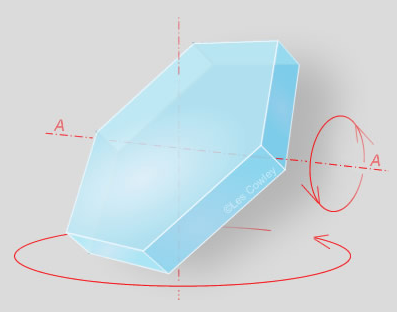Lowitz oriented crystals
Lowitz Oriented Crystals: Unveiling the Enigmatic Halo Phenomenon
In the realm of atmospheric optics, one phenomenon stands out for its elusive nature and captivating beauty - the Lowitz oriented crystals. These crystals, which take rotational positions around a near horizontal axis, have been a subject of intrigue and fascination since their discovery by Tobias Lowitz in 1790. Although their existence was initially doubted, advancements in digital photography have allowed us to capture rare glimpses of these enchanting halo arcs.
The classic Lowitz orientation is characterized by crystals assuming all positions about the axis LL. However, in practice, the range of angular positions may be more restricted. These crystals possess two side faces with a wedge angle of 60°, through which rays can pass in three distinct ways, giving rise to the formation of upper, middle, and lower Lowitz arcs. Additionally, when the sun is at a very low angle, rays internally reflected from the end faces create long pillar-like extensions known as reflected Lowitz arcs.
Observing and photographing Lowitz oriented crystals is a challenging endeavor due to their rarity. Clear examples of these halos remain few and far between, making each sighting a precious treasure for atmospheric optics enthusiasts. Nonetheless, with patience and a keen eye, one may be rewarded with the ethereal beauty that these crystals bestow upon the sky.
To fully comprehend the intricacies of Lowitz oriented crystals, it is essential to understand their geometric properties. These crystals possess a near horizontal Lowitz axis 'AA' that passes through two opposite prism edges and runs parallel to the hexagonal end faces. This unique orientation distinguishes them from other halo phenomena and contributes to their distinct appearance in the sky.
The formation of Lowitz arcs can be attributed to the interaction of sunlight with ice crystals suspended in the atmosphere. As sunlight passes through the crystal faces and undergoes refraction and internal reflection, it gives rise to the mesmerizing display of halo arcs. The precise angles and positions at which these arcs manifest depend on the orientation and geometry of the crystals, as well as the relative position of the observer.
Despite their rarity, Lowitz oriented crystals serve as a testament to the intricate dance between light and ice in our atmosphere. They offer a glimpse into the hidden wonders that surround us, reminding us of the vast complexity and beauty of nature.
In conclusion, Lowitz oriented crystals continue to captivate and mystify observers with their elusive halo arcs. While clear examples of these halos remain scarce, advancements in digital photography have allowed us to document their ethereal beauty. By understanding their geometric properties and the interplay between sunlight and ice crystals, we can appreciate the enchanting spectacle that these crystals bring to our skies. So, keep your eyes to the heavens and be ready to embrace the wonder of Lowitz oriented crystals whenever they grace us with their presence.

Lowitz oriented plates or columns take rotational positions - they don’t necessarily spin - about a near horizontal Lowitz axis ‘AA’. The axis passes through two opposite prism edges and is parallel to the hexagonal end faces.
The orientation and its halo arcs are named after Tobias Lowitz who first reported them in 1790. Their existence was long doubted but the halos are now occasionally observed and digitally photographed although clear examples remain very rare.
Crystals with the classic Lowitz orientation take all positions about the axis LL. In practice, the crystals may have a more restricted range of angular positions.
Rays can pass through two side faces with a wedge angle of 60° in three ways to form upper, middle and lower Lowitz arcs. Rays internally reflected from end faces form reflected Lowitz arcs, long pillar like extensions from the parhelia when the sun is very low.
Lowitz arcs Middle Lowitz arc
Images: Petri Hakkarainen, Gary Saunders
Note: this article has been automatically converted from the old site and may not appear as intended. You can find the original article here.
Reference Atmospheric Optics
If you use any of the definitions, information, or data presented on Atmospheric Optics, please copy the link or reference below to properly credit us as the reference source. Thank you!
-
<a href="https://atoptics.co.uk/blog/lowitz-oriented-crystals/">Lowitz oriented crystals</a>
-
"Lowitz oriented crystals". Atmospheric Optics. Accessed on November 26, 2024. https://atoptics.co.uk/blog/lowitz-oriented-crystals/.
-
"Lowitz oriented crystals". Atmospheric Optics, https://atoptics.co.uk/blog/lowitz-oriented-crystals/. Accessed 26 November, 2024
-
Lowitz oriented crystals. Atmospheric Optics. Retrieved from https://atoptics.co.uk/blog/lowitz-oriented-crystals/.